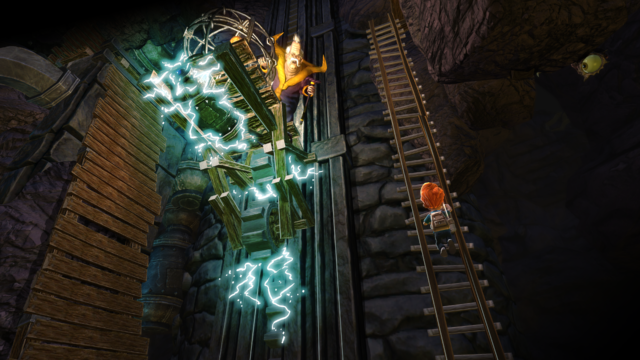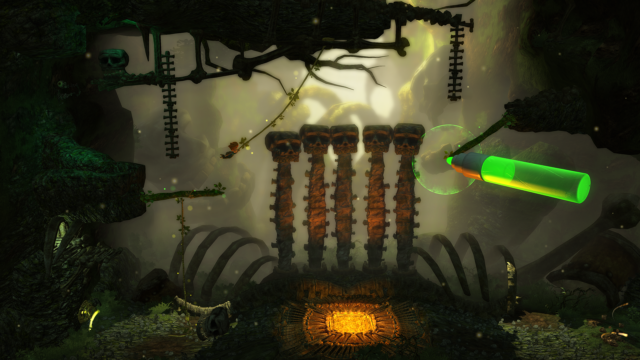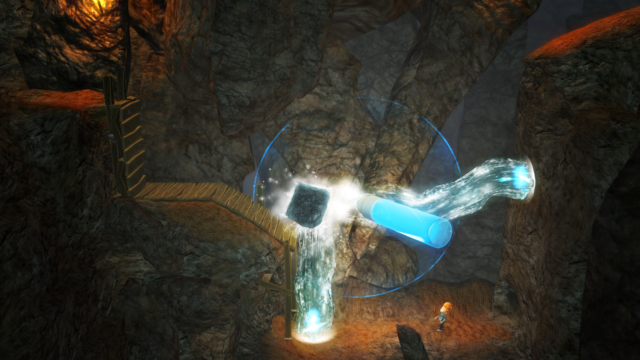Beautiful use of Unity; tight controls; smart puzzles; magic marker is great to use; fun lead in Max
Touch controls are slightly imprecise when the action gets too small on-screen; sometimes the game engine can struggle to keep up
If Max: The Curse of Brotherhood sounds familiar, it might be because the game has been out since 2013. Five years ago the title hit Xbox 360, then eventually moved over to PlayStation 4 and Xbox One, serving as a sequel to its predecessor Max and the Magic Marker. That original game was, ironically, a WiiWare and DS title, making The Curse of Brotherhood something of a full-circle return for the franchise. So was it worth the wait for Max to come home, so to speak, to a Nintendo console? The short answer is, absolutely.
The Curse of Brotherhood is a wonderful title that incorporates enough unique mechanics and gameplay hooks that it stands above the rank and file platformers on Switch. The game begins with our titular hero Max and his younger brother Felix. Felix is grinding on Max’s nerves so, like many typical older brothers are prone to do, he starts trying to find ways to get the kid out of his hair. Max stumbles across a spell online (that’s Generation Z for you), reads it aloud, and to his surprise a portal opens and monsters steal Felix away to a realm unknown. Max has guts, though, and jumps right in behind Felix to get his little bro back.

As far as stories go, The Curse of Brotherhood isn’t breaking new ground, but it’s a cute, quirky intro to our hero and the relationship he has with his sibling. Max looks like he was pulled from a Saturday morning cartoon, almost reminiscent of an orange-headed Calvin from the Calvin & Hobbes newspaper strip of yore, but more matured in his “advanced” years. At least, that’s how I ended up looking at him. Max is a typical kid and he’s easy to root for. That said, I appreciated that he was also really confident. Sometimes it’s nice to play things more realistically, but The Curse of Brotherhood is an over-the-top game and so it makes sense to have a lead who isn’t going to back down from something as “trivial” as enormous monsters and thousand foot death drops.
Developer Press Play worked some magic with the Unity engine, delivering a game that looks decently polished on Switch. Admittedly, as a platformer The Curse of Brotherhood does fall into some of the formulaic rut that so many other games in the genre do. There are standard “forest” and “swamp” levels on hand, but to their credit, the folks at Press Play weren’t content with just sticking to standard visual tropes. While some of the environments are thematically predictable, the actual design of them is anything but. Besides some visually arresting backdrops that play with form and shape like a master artist, the use of lighting perfectly enhances the atmosphere of each segment of the world, as well. Max is not on Earth and the game does a beautiful job of selling that.
Of course, as I am wont to say, I don’t care how much lipstick you put on a pig, a pig is a pig. Show me the bacon! I mean gameplay! Show me the gameplay! Thankfully, The Curse of Brotherhood is as polished mechanically as it is aesthetically. Max has a solid jump at his disposal and a respectable movement speed, so the more traditional pits and spikes and platforms can all be navigated with ease. It’s the puzzles that really stand out, however, thanks to the main mechanic/gimmick of the game: Max’s magic marker. Max is guided by a mysterious person throughout his quest who reveals to him that his marker is capable of conjuring all sorts of different things out of thin air. Learning to use the marker to draw these things into existence is the crux of the experience in The Curse of Brotherhood, and more often than not it works brilliantly.
It’s serendipitous that Press Play brought The Curse of Brotherhood to a console with such a large, luxurious touch screen as Switch, as the “drawing” component of the game is a perfect fit. While in Handheld mode, simply use a finger to effortlessly manipulate Max’s marker. Still, using the controller to guide the marker through the air works fine, too, and nothing in the game requires any real drawing skills. Instead, Max manipulates the marker mainly to drag and stretch things like vines, water spouts, and more to solve puzzles and traverse the landscape. Path out of reach? Raise the ground beneath Max’s feet so he can reach it. Need to travel down a river? Stretch out a branch, snip it off, and get aboard. As Max makes his way from one area to another, he learns new ways to interact with the game world with his marker, and they’re all intuitive and fun.

I was floored by how creative Press Play was in how the developer combined the different uses of the marker. Whether it’s crafting a makeshift raft and using a water plume to shoot it and Max down the river, or stretching vines upwards with a pillar of dirt to keep some deadly Lantern Bugs away, there are some real innovative uses of the marker to behold. The Curse of Brotherhood also isn’t afraid to take the training wheels off. There are no long, arduous tutorials here. Press Play was confident that the puzzle solutions would present themselves to players so long as they did a little thinking, and outside of the occasionally unreasonable challenge, I was always able to suss out how to proceed. I do wish that there was an option for some kind of help when the player gets really stuck, but for the most part it was never a real issue for me.
Beyond the main platforming portions of The Curse of Brotherhood are a handful of other diversions to keep things spicy. Chase scenes sneak in at random moments and they are insanely tense. Max has to run for his life and think on his feet in these segments. As the chase progresses, they’ll occasionally come to a sudden halt and transition into slow motion, giving the player a small reprieve to whip out the magic marker and begin drawing whatever Max needs to avoid a messy death. There are also Evil Eyes, essentially spy cameras, that are hidden throughout the game and must be pulled down, and Amulet pieces to uncover, as well. There’s plenty to do and see along Max’s journey that will keep things from ever getting boring.

As good as The Curse of Brotherhood is, it’s still not quite perfect even all these years later. As pretty as everything looks, sometimes the game can appear a tad grainy. It’s clear that Press Play pushed the Unity Engine hard, to the point that sometimes the action on-screen starts to have trouble keeping up. Also, while the implementation of the touch screen in Handheld Mode was a smart design move, sometimes the action pans out and shrinks things down, making it slightly difficult to position an asset where it needs to be on the first go. This is in part due to the fact that The Curse of Brotherhood was made to be played on a TV screen, not a portable one. That said, it’s still possible to use button controls in Handheld Mode (which was how I predominantly played), which largely mitigates this issue. I also didn’t think the action was overly cramped on Switch’s touch screen. Still, these are things that might cause some consternation in others, so be aware of them.
Overall, Max: The Curse of Brotherhood is a great game that feels like it’s really found a home on Switch. I’m glad that Press Play was able to bring the title to Nintendo’s latest console, as the form factor of Switch really meshes well with it. Whether at home or on the go, I found myself transfixed to The Curse of Brotherhood for long stretches, tackling each new puzzle and always thinking, “I’ll just do one more…” but always instead ending up doing several, if not dozens, more. The Curse of Brotherhood is available at both retail and on the eShop, so be sure to make your way to find a copy. It might be from 2013, but this is a title that has aged well and is as fresh today as it was back then.
Nintendojo was provided a copy of this game for review by a third party, though that does not affect our recommendation. For every review, Nintendojo uses a standard criteria.




 ShareThis
ShareThis





